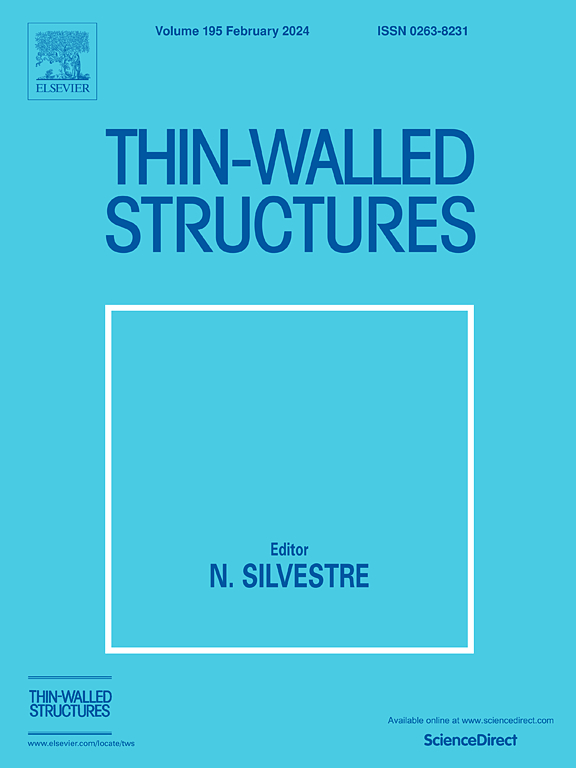Research on damage repair and high-velocity impact characteristics of thermoplastic composites
IF 5.7
1区 工程技术
Q1 ENGINEERING, CIVIL
引用次数: 0
Abstract
Low-velocity impact (LVI) can result in imperceptible damage to carbon fiber reinforced thermoplastic composites (CFRTP) laminates during service, leading to a reduction in structural strength. The thermal repair of damaged CFRTP laminates is conducted using the repairability of thermoplastic resin at high temperatures. However, the high-velocity impact characteristics of CFRTP laminates following thermal repair remain uncertain. This study examines CFRTP laminates made of two different materials (CF/PEEK and CF/PPS) with varying levels of low-velocity impact damage, and investigates the thermal repair process. A comparative experimental analysis examined the high-speed impact characteristics of CFRTP laminates under varying conditions. The results indicate that CF/PEEK laminates consistently exhibit superior compressive properties and impact resistance compared to CF/PPS laminates under similar conditions. Following damage from low-velocity impact, the compressive properties and high-velocity impact resistance of CFRTP laminates decrease, with CF/PPS laminates typically showing a lower performance retention rate. However, the thermal repair process proposed in this study significantly enhances the performance of CF/PPS laminates. Moreover, the degree of performance healing in CF/PPS laminates is consistently higher than that in CF/PEEK laminates, which is closely related to the semi-crystalline nature of PEEK resin.
热塑性复合材料的损伤修复和高速冲击特性研究
在使用过程中,低速冲击(LVI)会对碳纤维增强热塑性复合材料(CFRTP)层压板造成难以察觉的损坏,导致结构强度降低。受损 CFRTP 层压板的热修复是利用热塑性树脂在高温下的可修复性进行的。然而,热修复后 CFRTP 层压板的高速冲击特性仍不确定。本研究考察了由两种不同材料(CF/PEEK 和 CF/PPS)制成的 CFRTP 层压板的不同低速冲击损伤程度,并研究了热修复过程。对比实验分析检验了 CFRTP 层压板在不同条件下的高速冲击特性。结果表明,在类似条件下,与 CF/PPS 层压板相比,CF/PEEK 层压板始终表现出更优越的抗压性能和抗冲击性能。低速冲击造成损坏后,CFRTP 层压板的压缩性能和高速冲击耐受性会下降,CF/PPS 层压板的性能保持率通常较低。然而,本研究提出的热修复工艺可显著提高 CF/PPS 层压材料的性能。此外,CF/PPS 层压板的性能修复程度始终高于 CF/PEEK 层压板,这与 PEEK 树脂的半结晶性质密切相关。
本文章由计算机程序翻译,如有差异,请以英文原文为准。
求助全文
约1分钟内获得全文
求助全文
来源期刊

Thin-Walled Structures
工程技术-工程:土木
CiteScore
9.60
自引率
20.30%
发文量
801
审稿时长
66 days
期刊介绍:
Thin-walled structures comprises an important and growing proportion of engineering construction with areas of application becoming increasingly diverse, ranging from aircraft, bridges, ships and oil rigs to storage vessels, industrial buildings and warehouses.
Many factors, including cost and weight economy, new materials and processes and the growth of powerful methods of analysis have contributed to this growth, and led to the need for a journal which concentrates specifically on structures in which problems arise due to the thinness of the walls. This field includes cold– formed sections, plate and shell structures, reinforced plastics structures and aluminium structures, and is of importance in many branches of engineering.
The primary criterion for consideration of papers in Thin–Walled Structures is that they must be concerned with thin–walled structures or the basic problems inherent in thin–walled structures. Provided this criterion is satisfied no restriction is placed on the type of construction, material or field of application. Papers on theory, experiment, design, etc., are published and it is expected that many papers will contain aspects of all three.
 求助内容:
求助内容: 应助结果提醒方式:
应助结果提醒方式:


